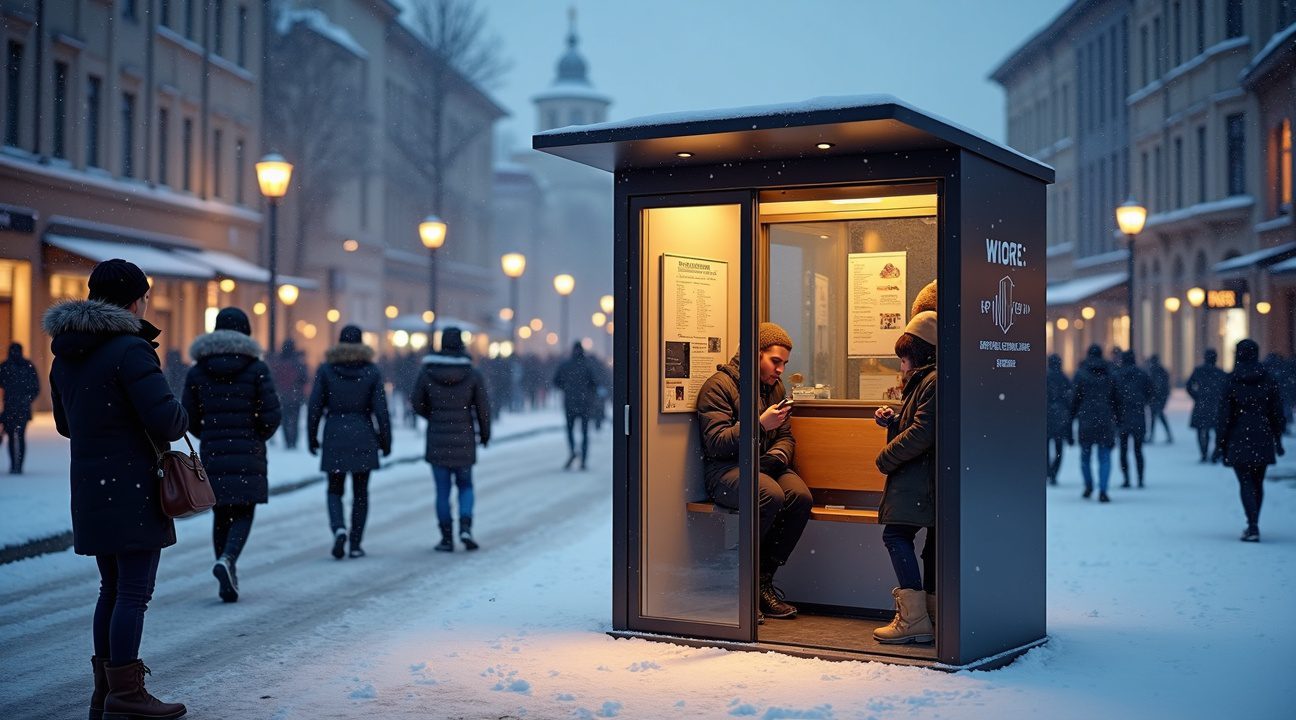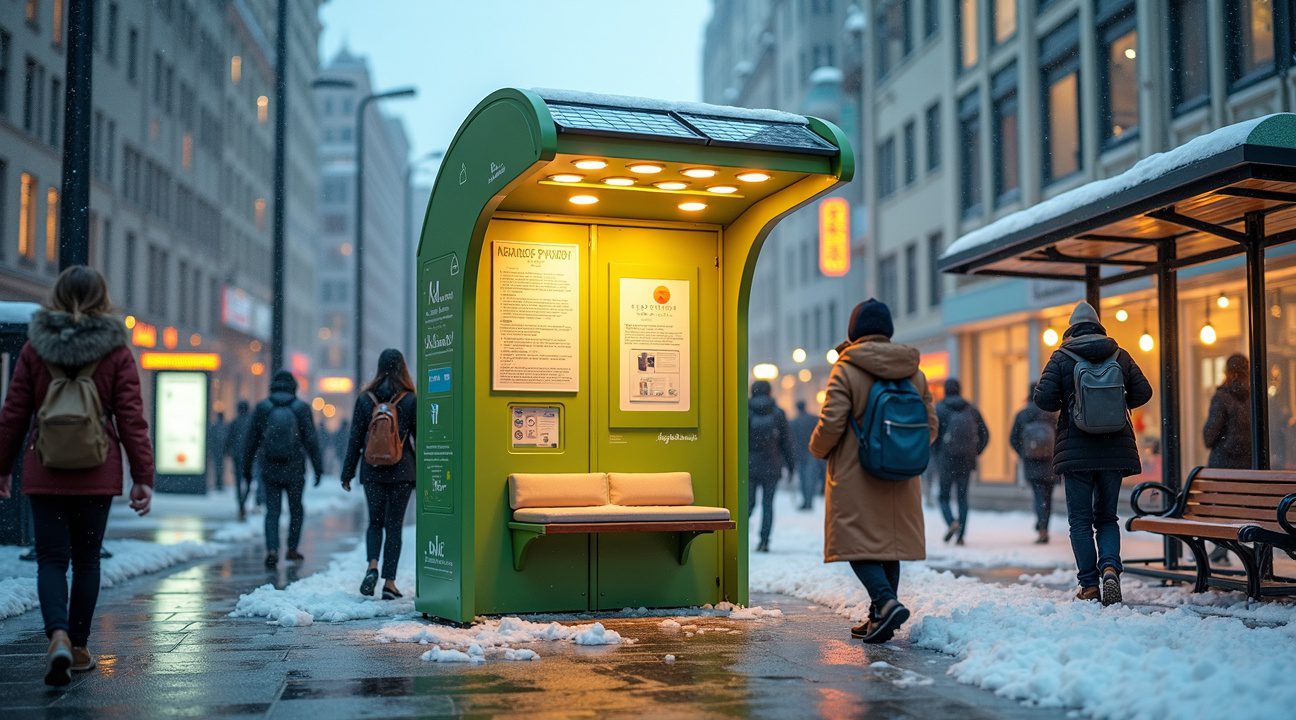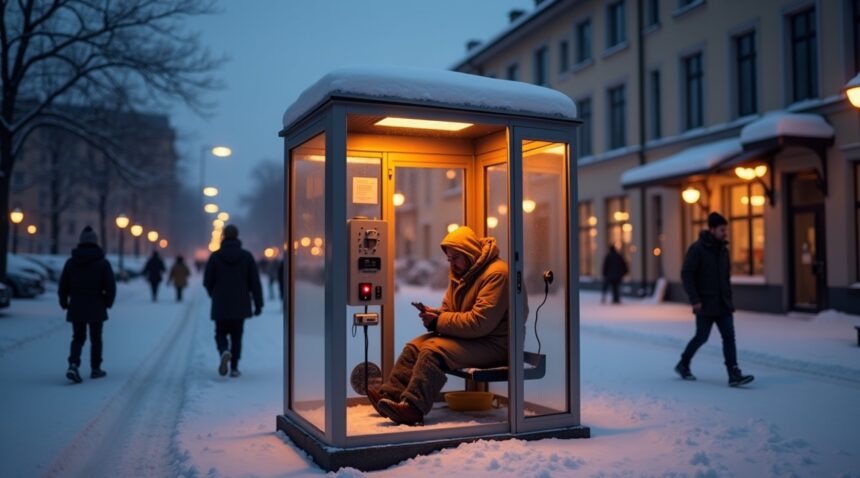Finland has pioneered an innovative solution to address homelessness by converting obsolete phone booths into fully-equipped heated shelters that provide essential modern amenities including warm seating, USB charging ports, and free Wi-Fi access. This creative repurposing initiative demonstrates how countries can transform abandoned infrastructure into life-saving resources while addressing multiple social needs simultaneously through cost-effective urban planning.
Key Takeaways
- Multi-purpose shelter design – Each converted phone booth includes heated seating systems, USB charging ports, free Wi-Fi, and weather-resistant protection to serve vulnerable populations during harsh winters.
- Digital inclusion support – The shelters provide essential connectivity that enables users to access emergency services, search for employment, connect with social services, and maintain communication with support networks.
- Cost-effective infrastructure reuse – The program leverages existing electrical systems and structures from obsolete phone booths, significantly reducing implementation costs compared to building new shelter facilities from scratch.
- Alignment with broader social welfare – The initiative complements Finland’s Housing First strategy by offering immediate relief stations while people transition to permanent housing solutions, reflecting the country’s comprehensive approach to homelessness.
- Scalable global model – The concept can be adapted by communities worldwide to address local homelessness challenges, with modifications based on specific climate conditions, available resources, and cultural needs.
Finland Transforms Redundant Phone Booths Into Life-Saving Heated Shelters
Finland’s innovative approach to addressing homelessness showcases how creative thinking can transform abandoned infrastructure into life-saving resources. I find this initiative particularly compelling because it demonstrates how countries can repurpose obsolete technology to serve modern social needs.
Essential Features and Equipment
Each converted phone booth includes several critical features that make them genuinely useful for people seeking shelter:
- Heated seating systems that provide warmth during Finland’s harsh winters
- USB charging ports for mobile devices and other electronic equipment
- Free Wi-Fi connectivity for communication and accessing essential services
- Weather-resistant design that protects occupants from snow, rain, and wind
The transformation process involves completely retrofitting the interior of these once-common communication hubs. I’ve noticed that this repurposing strategy effectively addresses multiple needs simultaneously — providing shelter, connectivity, and basic comfort to vulnerable populations.
Finland’s decision to implement this program stems from practical necessity. Traditional phone booths became largely obsolete as mobile phone adoption reached near-universal levels across the country. Rather than demolishing these structures, municipal authorities recognized their potential as micro-shelters. Tesla’s partnership strategies with various companies demonstrate similar innovative thinking about repurposing existing resources.
The heated shelters serve multiple demographics beyond just homeless individuals. Workers waiting for transportation, tourists needing temporary respite, and anyone caught in unexpected weather conditions can benefit from these facilities. This broad utility ensures the shelters receive regular use and maintenance attention.
Installation costs remain relatively low compared to constructing new shelter facilities from scratch. The existing electrical infrastructure in most phone booths provides a foundation for heating systems and charging capabilities. Municipalities can implement Wi-Fi connectivity through partnerships with local internet service providers.
I believe this initiative represents a scalable model that other countries could adapt to their specific climates and social needs. The concept works particularly well in urban areas where phone booth density was historically high. Cities across Scandinavia and other cold-climate regions have already expressed interest in similar programs.
The shelters don’t replace comprehensive homelessness solutions but provide immediate relief during critical moments. They offer dignity and basic human comfort while individuals work with social services to find permanent housing solutions. Each unit can accommodate one person comfortably, ensuring privacy and reducing potential conflicts.
Modern Amenities Make These Shelters More Than Just Warm Spaces
Finland’s innovative phone booth shelters represent a significant leap beyond basic warmth, incorporating carefully selected amenities that address today’s essential connectivity needs. These upgraded shelters demonstrate how thoughtful design can transform simple structures into comprehensive support hubs for community members.
Essential Connectivity Features
The heated seating provides immediate comfort for users seeking refuge from harsh weather conditions. USB charging ports address a critical modern necessity, allowing people to power their smartphones and other essential devices. Free Wi-Fi access ensures users can maintain vital connections to information networks and digital services.
These connectivity options serve multiple practical purposes:
- Emergency communication access through charged devices
- Job searching and application submission capabilities
- Health service appointments and telehealth consultations
- Banking and government service access
- Educational resources and skill development opportunities
- Social connection maintenance with family and friends
Supporting Digital Inclusion and Safety
The combination of device charging and internet access creates opportunities for digital participation that might otherwise be impossible for vulnerable populations. People experiencing homelessness or housing instability often face significant barriers to maintaining device power and internet connectivity. These shelters eliminate those obstacles, providing equal access to digital resources that have become fundamental to modern life.
Device charging capabilities prove particularly crucial during emergency situations. A powered phone can mean the difference between accessing emergency services and remaining isolated during critical moments. The shelters essentially function as community safety nets, ensuring people maintain their connection to support systems even during their most challenging circumstances.
Wi-Fi access enables users to research local services, connect with social workers, or access government assistance programs online. This digital access promotes independence and self-sufficiency by allowing people to pursue solutions to their situations directly. The shelters become more than temporary refuges; they transform into gateways for positive change and community reintegration.
Much like how Tesla and JD.com partnerships demonstrate innovation in technology collaboration, Finland’s shelter project shows how traditional infrastructure can evolve to meet contemporary needs. These amenities work together to create comprehensive support systems that address both immediate physical comfort and longer-term connectivity requirements, establishing a new standard for community care infrastructure.
How This Initiative Reflects Finland’s Broader Social Welfare Commitment
Finland’s transformation of old phone booths into heated shelters demonstrates the country’s unwavering dedication to comprehensive social welfare policies. I see this project as more than an innovative recycling effort—it represents a fundamental philosophy that prioritizes human dignity and practical solutions for society’s most vulnerable members.
The community has embraced this initiative enthusiastically, recognizing it as both a visible symbol of care and an effective response to homelessness challenges. Citizens appreciate seeing concrete action that addresses real needs while repurposing existing infrastructure. This positive reception reflects Finland’s cultural values that emphasize collective responsibility and social solidarity.
Integration with Finland’s Housing First Strategy
This shelter initiative aligns seamlessly with Finland’s acclaimed Housing First program, which revolutionized how the country approaches homelessness. The Housing First model prioritizes providing stable housing without preconditions, then wraps support services around individuals to address underlying issues. These converted phone booths serve as temporary relief stations that complement this broader strategy by offering immediate assistance while people transition into permanent housing solutions.
Finland’s social welfare system operates on evidence-based principles that prioritize prevention and early intervention. The phone booth shelters exemplify this approach by providing accessible resources before situations become critical emergencies. With heated seating, USB charging capabilities, and Wi-Fi access, these shelters acknowledge that maintaining connections and basic comfort can be crucial for people seeking employment or social services.
The initiative also reflects Finland’s commitment to innovative problem-solving within government policy. Rather than allowing outdated infrastructure to decay, officials recognized an opportunity to address multiple challenges simultaneously. This creative approach to urban planning demonstrates how progressive policies can emerge from practical resource management.
Finland’s broader economic policies support such initiatives through strategic budget allocation that treats social welfare as an investment rather than a cost. The country consistently ranks among the world’s happiest nations, partly because residents see their tax contributions creating tangible benefits for everyone. These phone booth shelters represent exactly this type of visible return on public investment.
The success of this program fits into Finland’s pattern of addressing social issues through comprehensive, multi-faceted approaches. Just as technological partnerships drive innovation in other sectors, Finland’s social policies blend traditional welfare concepts with modern technology and creative urban planning. This holistic perspective ensures that even small-scale projects contribute to larger societal goals, creating a safety net that’s both practical and dignified for those who need it most.

Finland’s Approach Stands Out Among Global Phone Booth Innovation Projects
Finland’s transformation of phone booths into heated shelters represents a distinctive approach that sets the Nordic country apart from similar repurposing efforts worldwide. While numerous nations have breathed new life into these iconic structures, few have prioritized the critical combination of survival necessities and digital connectivity that Finland has achieved.
Global Phone Booth Repurposing Trends
Countries across the globe have embraced creative phone booth transformations, yet most focus on commercial or cultural applications rather than addressing homelessness directly. The United Kingdom has converted many red phone boxes into mini-libraries, defibrillator stations, and even tiny coffee shops. Japan has reimagined some booths as aquariums and art installations. These projects, while innovative, don’t address the pressing need for emergency shelter that Finland’s initiative tackles head-on.
Germany and parts of the United States have experimented with converting phone booths into charging stations and Wi-Fi hotspots, but these modifications typically serve convenience rather than survival. Technology partnerships in other countries have focused primarily on enhancing urban connectivity for general public use, missing the opportunity to serve vulnerable populations.
Finland’s Comprehensive Survival-Focused Design
What distinguishes Finland’s heated shelter project is its holistic approach to addressing homelessness through practical design elements. The integration of heated seats addresses the immediate danger of hypothermia in Finland’s harsh winters, while USB charging ports ensure individuals can maintain communication with emergency services or support networks. Free Wi-Fi access enables people to seek employment opportunities, access social services, or stay connected with family members.
This comprehensive approach reflects Finland’s broader social welfare philosophy, where technology serves humanitarian purposes rather than purely commercial interests. Unlike other technological innovations that prioritize convenience, Finland’s shelters address genuine life-threatening situations while maintaining human dignity.
The Finnish model demonstrates how urban infrastructure can serve multiple purposes simultaneously. These shelters function as emergency warming stations during extreme weather events while providing consistent access to communication tools that many consider basic necessities in modern society. This dual-purpose design maximizes the utility of existing urban infrastructure while minimizing additional construction costs and urban space requirements.
Why This Model Could Work in Communities Worldwide
Finland’s innovative phone booth transformation addresses a critical global challenge that extends far beyond national borders. I see this initiative as a blueprint for communities worldwide struggling with homelessness and social isolation. The genius lies in taking existing infrastructure that would otherwise become urban waste and converting it into life-saving resources.
Universal Challenges Meet Creative Solutions
Cities across different continents face remarkably similar problems. Homeless populations need immediate shelter from harsh weather conditions, while municipalities struggle with budget constraints for social services. The Finnish model offers a cost-effective solution that doesn’t require massive infrastructure investments. Instead of demolishing outdated phone booths, communities can repurpose them into functional support stations.
Practical Benefits That Scale Globally
This approach delivers multiple advantages that translate across cultures and climates:
- Immediate emergency shelter from severe weather conditions
- Essential modern amenities like charging capabilities and internet access
- Minimal ongoing operational costs compared to traditional shelter programs
- Quick deployment timeline that doesn’t require lengthy construction projects
- Visible community commitment to supporting vulnerable populations
The model’s adaptability makes it particularly attractive for diverse environments. Coastal cities might focus on storm protection features, while urban centers in colder climates could emphasize heating systems. Tech-forward communities might enhance the digital amenities, perhaps drawing inspiration from innovative partnerships in other sectors.
Communities worldwide can modify the concept based on local needs and available resources:
- Partnering with telecommunications companies to upgrade existing infrastructure
- Collaborating with local manufacturers to create new units
- Designing around environmental and cultural-specific demands
The key lies in recognizing that small-scale interventions can generate significant social impact.
The sustainability aspect also resonates globally. Rather than contributing to electronic waste, communities transform obsolete technology into functional social infrastructure. This circular economy approach aligns with environmental goals while addressing human needs.
Local governments can implement pilot programs with minimal risk, testing the concept in specific neighborhoods before broader deployment. Success stories from these initial installations often generate community support and additional funding for expansion. The visible nature of these shelters also raises awareness about homelessness issues, potentially spurring broader community engagement and support.
I believe the Finnish model proves that innovation doesn’t always require massive budgets or complex technology. Sometimes the most effective solutions emerge from creative thinking about existing resources. Communities worldwide can adapt this concept to create their own versions of supportive infrastructure, whether through converted phone booths, bus stops, or other underutilized urban fixtures.

Sources:
Finland converts old phone booths into free heated shelters
FactPoint Post
OECD Economic Surveys: Finland 2025
Y-Foundation (via A Look Into Finland’s Housing First Initiative)


